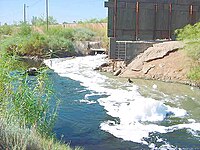
Photo from wikipedia
Overcrowded urban areas are exposed to quotidian loads of toxic metals and PAHs. Simultaneous analysis of mentioned pollutants in surface soil samples of a crowded urban area in Tehran City… Click to show full abstract
Overcrowded urban areas are exposed to quotidian loads of toxic metals and PAHs. Simultaneous analysis of mentioned pollutants in surface soil samples of a crowded urban area in Tehran City is considered in this study. A total number of 112 samples were collected from pollution hotspots including gas stations, construction sites, bus terminal and waste recovery centers in summer 2016. Total, anthropogenic and bioavailable concentrations of metals, cadmium, cobalt, chromium, copper, manganese, nickel, lead and zinc, as well as ecological risk index (RI) values were calculated. Rather than Cd, the concentration of other metals was not remarkably different from reference values. The descending order of anthropogenic and bioavailable fractions in metals was proved to be as follows: Cd (87.87%) > Cr (40.14%) > Ni (38.64%) > Pb (37.40%) > Co (8.42%) > Cu (7.98%) > Zn (5.57%) > Mn (3.94%) and Cu (6.84%) > Zn (6.47%) > Pb (3.98%) > Ni (3.97%) > Cr (1.99%) > Cd (1.98%) > Mn (1.45%) > Co (1.39%), respectively. The results of the RI values also indicated that around 80% of total samples lie within a considerable ecological risk level. The total concentration of 16 EPA-approved PAHs was detected to be within the range of 0.62 and 3.51 mg/kg. The majority of PAHs detected in all samples was those with relatively higher molecular weights (higher number of aromatic rings). Accordingly, the major source of PAHs in surface soils was determined to be petroleum/gas combustion due to traffic loads and heating systems. The synergy observed in spatial distribution of toxic metals and PAHs confirms relatively identical pollution sources and at the same time exacerbates the adverse effects on human and ecological health.Article HighlightsThe combined approach of toxic metals and PAHs in urban soil analysis is considered.The source detection of PAHs in urban soils is determined.The source detection of toxic metals in urban soils is investigated.The fractionation of toxic metals in bulk, anthropogenic and bioavailable fractions is performed.
Journal Title: International Journal of Environmental Research
Year Published: 2019
Link to full text (if available)
Share on Social Media: Sign Up to like & get
recommendations!